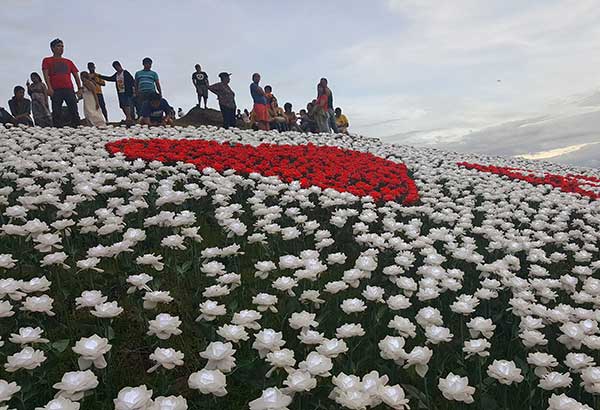Baybay City: farm, faith and eco-tourism

Baybay’s 16,000 Blossoms Park adorned by 16,000 LED lights. rodel balierbarre
MANILA, Philippines — The beguiling city of Baybay in Leyte is emerging as Eastern Visayas’ hub for faith, farm and eco-tourism – three new sectors of the industry the Department of Tourism (DOT) is developing because of their growing markets.
Proclaimed a component city of Leyte in 2007, Baybay has been quietly making a name as a destination because of the unique confluence of these three tourism sectors.
For now, Baybay may not be on top of the list for recreation and sight-seeing, but it offers a unique blend of rural allure and urban living comforts that has seen it grow in popularity among travel bugs.
In a recent visit, Undersecretary Silvino Tejada who handles the newly-created faith, farm and eco-tourism portfolio, pledged the DOT’s support for the city’s growing tourism industry.
Faith tourism
Baybay is home to the Diocesan Shrine of San Antonio de Padua, which draws pilgrims to venerate the century-old image of the saint which is believed to be miraculous.
Located in the coastal barangay of Pomponan, Catholic faithful from all over the country pay tribute to the saint every 13th day of the month, in an act of devotion which starts the day before. A traditional religious dance called “sirong” is performed during the saint’s patronal feast on June 13, which falls two days before Baybay’s cityhood day.
The church, which receives over 300,000 devotees a year, constantly ranks as the top cultural attraction in Region 8. This number is part of the nearly 650,000 day visitors who swing by Baybay annually, the highest in the region based on data from DOT-8.
Another religious attraction is the Baybay parish church, a baroque structure started in 1852 by Spanish friar Vicente Coronado and continued by Maestro Proceso.
The town became a parish on Sept. 8, 1835 with the invocation of Our Lady of the Immaculate Conception as patron.
The church was destroyed by fire in 1866, except for the Holy Cross Chapel, and was rebuilt in 1870 with renowned sculptor and painter Capitan Mateo Espinoso applying the finishing touches to lend magnificence to the house of worship.
The church is in the heart of the “heritage lane” of well-preserved Spanish and American-era ancestral houses, which will transport visitors back in time when they visit these living museums.
The parish celebrates its patronal feast on Dec. 27 while the city government has launched the Binaybayon Festival to showcase the city’s rich cultural heritage.
Farm tourism
Baybay has been showcasing its agriculture potential long before Republic Act 10816 or the Farm Tourism Development Act 2016 was signed into law.
Thanks to the presence of the Visayas State University, a prominent institution of higher learning at the forefront of agricultural education, research and development. Formerly known as the Visayas State College of Agriculture, this sprawling campus has been sowing the seeds of farm tourism for decades with its vast gardens, demo farms and fertile plots.
Sandwiched between the undulating Pangasugan mountain ranges and the scenic Camotes Sea, this resort-university’s 1,479 hectares feature mostly greeneries, and houses the National Abaca Research Center, National Coconut Research Center-Visayas, the Philippine Root Crops Research and Training Center as well as regional centers of agencies on agriculture and environment.
Baybay also boasts of a 13,820-hectare coconut plantation, the biggest in Eastern Visayas, luring big agro-industries such as SC Global Coco Products Inc. and SC Global Food Products Inc., the world’s largest producer of organic coconut oil.
The city is also host to Ching Bee Trading Corp., the world’s biggest trader of abaca fiber, and Specialty Pulp Manufacturing, Inc., Asia’s largest abaca pulp mill.
These factories form the core of a specialized industrial tourism circuit for bench-marking of best practices and technologies.
Eco-tourism
Baybay has the longest coastline in Leyte, thus its name which literally means beach. And it goes without saying that among its top tourist attraction is its coastline, dissected by rivers and streams emanating from the Pangasugan ranges, which has some remarkable flora and fauna.
The wind-swept Lintaon Peak, the city’s highest point, affords guests a commanding view of the city, the Camotes Sea and islands across the channel.
As part of its 10th cityhood day, Baybay recently opened the 16,000 Blossoms Park adorned by 16,000 LED lights, which light up the mountain at night.
The park is comprised of white and red blooms embedded in the grassy meadow forming the phrase “I Love Baybay.”
According to mayor Carmen Cari, the park is part of the city’s tourism development plan which will transform the area into the Lintaon Ecotourism Zone featuring an information center, view deck, pavilion, picnic areas and other tourist facilities.
A tall image of the city’s patron saint Immaculate Conception will also be erected to make it a pilgrimage site in addition to the San Antonio de Padua Shrine nearby.
For a complete experience, the more adventurous can explore the nearby Lintaon Cave, scale Mt. Pangasugan and take a dip in the rejuvenating waters of Bakwitan River and Falls.



















